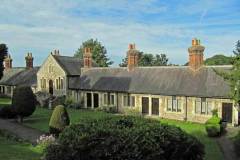Harbledown
The Hospital of St Nicholas was founded in 1084 by Archbishop Lanfranc for 60 lepers. Henry II paused here in 1174 en route to the cathedral where he did penance for the murder of Thomas Becket. During the 14th century, with the virtual eradication of leprosy in England, the foundation was converted to almshouses. Erasmus and his friend John Collet visited the site in 1519, also en route to the cathedral, and were invited to kiss the shoe buckle of Thomas Becket. It reached its present status in 1565 when Archbishop Parker issued new statutes for the running of the organisation.
The present buildings consist of the church of St Nicholas, the almshouses (rebuilt 1840), the 17th century Frater (dining room) also restored in the 1840s, and, on land of the adjacent farm, the well associated with the Black Prince. A stone church has stood on this site since the 12th century. Evidence can be seen of the architecture of this and many later periods (see images). Administration of the almshouses is carried out by a Council of Management which also administers St John’s almshouses in the city. St Nicholas’ ceased to be a separate parish church in 1934 and now forms part of the parish of St Michael’s Harbledown. Eight 14th century mazers (wooden bowls) from the Hospital are were kept in the city museum (formerly Poor Priests’ Hospital) and now the Cathedral Archives. One of these, supposedly incorporating the shoe buckle of Thomas Becket, was on temporary display in the cathedral Treasury. Residents of the almshouses maintain the link with those suffering from leprosy – their church collections support work at the Kindwitwi Mission in Tanzania.
What to see:
- St Nicholas church from the west (Image 1)
- almshouses (Image 2)
- Frater (Image 3)
- Black Prince’s well (Image 4) – the carved three ostrich feathers are probably 19th century
- Norman west door with chevron (zigzags) (Image 5)
- sloping floor of nave and chancel (Image 6) – supposedly to ease the task of cleaning the floor when lepers prayed here
- 14th century treasure chest (Image 7)
- medieval font (Image 8)
- a rare early cooking cauldron (Image 9)
- early wooden stairs lead to tower (Image 10) and its four bells
- 13th century wooden bench (Image 11)
- Our Lady of Merton wood carving by Sister Concordia of Minster Abbey erected 2010 (Image 12)
- valuables formerly in the church lock-up area (Image 13)
- one of several 14th century wall paintings – the Virgin holding a book (Image 14) – restored 1992
- 14th century roof with beams and king posts (Image 15)
- capital on 14th century octagonal NE pier – showing two birds sharing one head (Image 16)
Access: by arrangement
Sources: Ingram Hill et al (2004); Newman (2013); article by J Purchese in Osborne (2000); also pamphlet in church St Nicholas Harbledown by Derek Ingram Hill (nd)
DL
















